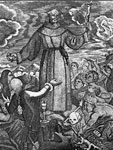On a Mission: Junípero Serra in New Spain
Question

What was Junípero Serra’s relationship to the San Gabriel Mission and the Native American people in the area?
Answer
Father Junípero Serra was born Miguel Joseph Serra in Spain in 1713. Educated as a friar in the Order of St. Francis, he immigrated to New Spain in 1749, where he worked as both a missionary and a university administrator. In 1769, Serra led a group of Franciscan monks into Alta California, and there oversaw the founding and maintenance of a chain of missions along the Californian coast. Mission San Gabriel was the fourth mission to be built in this chain. While Serra selected the site for the mission (a site that was eventually changed) he did not personally visit the mission station until September 1772, a year after its founding.
Serra oversaw a mission system that rapidly transformed the environment and living situation of California's indigenous communities. The friars, and the soldiers sent to accompany them, brought European domestic animals—cows, pigs, and sheep—into the region where they quickly reproduced past the point of containment. Non-native species of grasses and weeds were transported via supplies from New Spain and overran the local flora upon which Native communities depended for food. Thousands of indigenous people were pushed by these events to move to the missions in order to secure the means of their subsistence.
The friars forced Native people to work for the missions, often growing the crops upon which the mission community depended. The Franciscans strove to convert Native people to Catholicism, requiring that individuals attend mass, memorize catechisms, confess their sins, and accept harsh physical punishment for behaviors the friars considered sinful. Kinship structures were deeply disrupted by the friars' attempts to remake Native families according to a Christian, Spanish model. This situation was further compounded by mortality rates at the missions, which vastly outpaced those in other areas of the Spanish empire or Europe itself. Infants and children were especially vulnerable. The rampant spread of diseases such as syphilis and gonorrhea among the Native population made it hard for communities to replace the members they lost.
Native people were not passive in the face of such change. Many individuals sought to preserve their traditional spiritual belief systems—some of which, like that of the Luiseño, mapped easily onto the central ideas of Catholicism, and some of which did not—as well as offering political resistance to the authorities of New Spain. The environmental and epidemiological changes brought about by the missions, however, made it difficult for families or communities to survive without some connection to the missions, be it wholesale removal or trade.
Serra died in California in 1784. In 1987 he was beatified by Pope John Paul II, a prerequisite for the attainment of sainthood. Controversy persists as to whether Serra should be sainted, given his administration of a mission system that was so destructive to the lives of California's Native people.
For more information
Hackel, Steven W. Children of Coyote, Missionaries of Saint Francis: Indian-Spanish Relations in Colonial California, 1769-1850. Chapel Hill: University of North Carolina Press, 2005.
Sandos, James A. Coverting California: Indians and Franciscans in the Missions. New Haven: Yale University Press, 2004.
